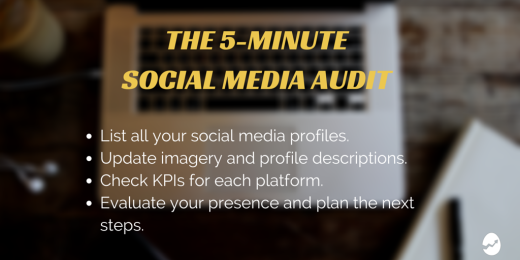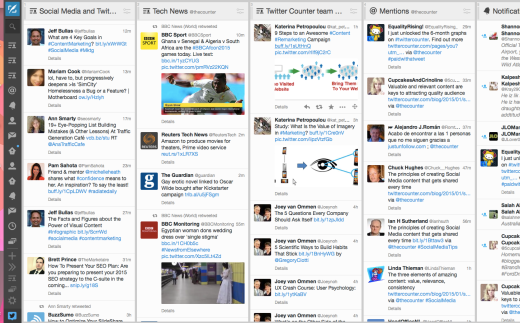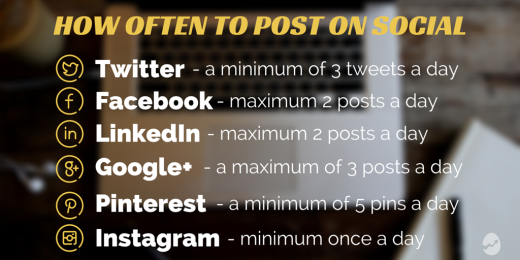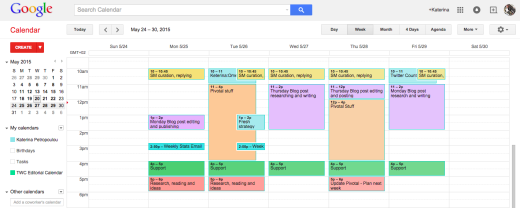
There’s this common misconception that managing social media on a professional level is as easy and breezy as uploading an image on Facebook with a simple caption to go with it. But, you and I both know that there’s so much more to it.
Managing social media effectively is about posting the right content on the right platform, establishing your brand’s authority, thinking ahead, building relations, measuring and monitoring your performance, and the list goes on and on.
Basically, social media management can be a full-time job but it can become even more of a challenge if managing your brand’s social media presence is only part of your daily tasks.
So where to begin? Take a big breath and master these ten secrets that will help you save a ton of time and turn social media management into a piece of cake.
Planning an audit
As dreadful as it may sound, a social media audit is something that you should do on a frequent basis. If you’ve never done a social media audit for your brand, now is a good time as we’re heading towards the end of the first half of the year.
Social media audits help you get a grasp of how you’ve been doing so far in terms of meeting your social media marketing goals, if everything you had planned at the beginning of the year are working and whether you need to reconsider certain tactics of your social media plan.
But where to begin? Basically from the top down, going into as much depth as you need, in order to gain a better overview of your social media activity so far.
Take a look at a few basic steps for a super quick social media audit you can do on a frequent basis.
Step 1: List all the platforms you are active on with links to your social media profiles.
Step 2: Update any imagery and profile description that needs to be updated.
Step 3: Check some key metrics such as audience growth, reach, engagement and traffic generated from this platform.
Step 4: Evaluate your presence on each social media platform by checking your KPIs. This process will help you gain some perspective and assess where you should focus your efforts from now on.
Creating a content firehose
Many of the social media managers I speak to face the same challenge: Content curation. The truth is that finding high quality, relevant content to share on social media can be time-consuming. But fear not! What you need to make it easier is to create a content curation system that works for you.
A few tools that can help you build up your own system:
Feedly: Gather all your favorite news resources on Feedly and browse them every morning to find relevant, useful content to share and of course use it as an inspiration to for creating your own content. One of its helpful features is that it immediately gives you an idea on what’s most shared on a given day with the number of shares being shown next to each headline.
Unroll.me: You probably hate email as much as everyone else but email and newsletters can deliver some hidden gems ready to be tweeted, pinned, instagrammed, you name it. Unroll.me might come in handy in this case. What it does is gather all your newsletters in one place delivering all-in-one emails you can easily browse.
Smart content recommendation tools:
Answering to social media managers’ need of curating content, there are quite a few brilliant tools that recommend you content you can share on your social media platforms. Content that is relevant to you and your audience. Swayy, and Groupiest are both tools that can recommend you relevant content to tweet, based on your community and the topics you are interested in.
Going all visual
Once you find the amazing content to share on social media, it is time to make it shareable. Research has shown that visuals are processed 60,000 times faster in the brain than text which basically explains the superpowers of visual content when it comes to social media marketing.
But you don’t necessarily need to be a pro in video editing or designing to create engaging, compelling visual content for your social media posts. There’s the easy way to go for it.
Social media platforms like Vine and Instagram allow you to create fun, short videos that can also be easily shared on Facebook and Twitter. Oreo is a great example of a brand that has made the most out of Vine on their Twitter feed, with great results on their engagement.
Canva is must-use tool for every social media manager. It allows you to create professional looking images for social media in less than 3 minutes. The best part is that you shouldn’t worry about the size of your images since Canva offers templates of visuals for all major platforms.
Infographics are a great way to turn boring data into insightful, engaging visuals that can easily be shared across different social media platforms. Piktochart is just the right tool for creating infographics in a few minutes. What is helpful is the wide range of themes to choose from and the freedom the tool offers in customizing templates to fit your style and needs.

Making time for engagement
This is something that some social media managers neglect as they spend so much time and effort on the content they will post and on measuring how this content is distributed and received. But social media is not just a distribution channel for your brand and are definitely not to be treated as the platform for sharing your press releases.
The idea is to be conversational and interact with your community. Spending as much as a few minutes a day asking questions, replying to comments, engaging with your community and sharing their content can really make a difference.
Twitter chats are another way to engage in your niche, build authority for your brand and expand your reach. They provide you with the chance to be useful and relevant, offer your help and communicate your brand’s voice and identity in a constructive way.
Twitter listing everyone
When I say everyone, I mean everyone. Twitter lists are a powerful tool with endless possibilities to make your life as a social media manager much, much easier simply because they can help you:
1. Listen
Having a good monitoring system in place is one of the most important elements of a good social media strategy and Twitter lists can make Twitter monitoring much easier by adding them to your Twitter dashboard.
2. Build relationships
Twitter lists is what Monica Geller would refer to as ‘organized fun’. You can use them to build Twitter relationships with influencers in your field and reach out to new people in your niche. This way, you can build authority and a strong community around your brand in a more efficient way.
3. Curate content
Twitter lists are a great way to keep up with all that’s happening in real time and curate content you can share with your followers. For example, you can keep up to date with all the latest from social media influencers or influencers in your industry.
In addition to this, since lists can be public, you can create your own custom feed for people to subscribe. This way you can increase your account’s visibility and build credibility. Creating a Twitter list that adds value on a specific topic can increase the chances of your account popping up in search results both on Twitter and Google.
Planning ahead
When you have a social media content calendar, managing your accounts becomes a lot less daunting. Organizing the way you create and curate content helps you save a lot of time in managing social media but also allows you to have a clear overview of what type of content you post across different platforms, allows you to better plan your social media marketing campaigns and of course gives you a solution when you get to the “What should I post now” point.
The easiest way to organize a content calendar is by using a separate sheet for each month, with activities further broken down by month or day, depending on the volume of content you plan to publish.
How to create your social media content plan
Step 1: Decide how often you should post across platforms
Although there are some general rules of thumb on the posting frequency for each social media platform, the ultimate posting recipe is different for every account as it often depends on the industry and audience, the type of content you post and of course the platform itself.
For example, for Twitter Counter’s Twitter account, we found out that shifting to a once-an-hour, round the clock posting strategy had a positive effect on the overall engagement of our account.
In general, according to a recent Buffer research a good starting point for posting across platforms is this:
Note: it is important to experiment with different frequencies for each platform. Timing is equally important to maximize the exposure of your posts depending on where your audience is.
For Twitter, Followerwonk can tell you when your Twitter followers are online and Twitter Counter calculates the most successful times and days in a week based on your engagement metrics.
Facebook insights offers information on the best times to post for maximum reach whereas for Google+, social media science concludes that weekdays from 09:00 am to 11:00 am are the best.
Step 2: Decide what to post and where
Once you have decided on the best frequency and timing recipe for each platform it is time to decide on the type of content to post on each platform. If you have marketing campaigns planned through out the year, you can already start thinking your message, the visuals and the platforms you will want to use.
It is important to keep in mind that even though you could essentially post the same content on every medium, its structure and copy need to be adjusted to the specifics of each platform.
For example, on LinkedIn link posts with linger copy work better than on Facebook. On Twitter, the 80/20 rule is a rule to tweet by. This means that a good content tactic is sharing 20 percent your own content and 80 percent third party content from trustworthy, reliable sources. Twitter suggests images or video as the best option to accompany your tweets and boost your reach.
Step 3: Write your copy and create your visuals1
When writing your social media copy, keep in mind that length matters. Social media scientist2, Dan Zarrella suggests that tweets that are 100 to 115 characters long are more likely to be retweeted.
On Facebook, posts that are maximum 40 characters long do perform better in terms of engagement, whereas Google+ and LinkedIn call for longer updates. For a quick checklist of what you should keep in mind when writing social media copy take a look at this amazing infographic from Quick Sprout.
Step 4: Fill up your social media content calendar
The last step of your social media content strategy is creating a content calendar. This way, you gain an overview of what you are posting on each platform and it is much easier to plan relevant content around important dates such as product releases, holidays and so on. Oh, and of course you’ll never need to ask yourself ‘What do I post now?’
Depending how much of a visual type you are, you can either use a template or use your scheduling tool to plan your content ahead.
Remember that on social media, it is OK to repeat content as long as you present it in a fresh way using a different visual or copy for example. In fact, repeating content on social is key to boosting traffic and expanding your reach.
Loving thy automation
Managing several social media platforms without some help from automation tools would be impossible. Otherwise, implementing your social media editorial calendar and following through your plan would be much harder. Take a look at three tools that make social media automation a piece of cake.
Buffer is the ultimate tool for scheduling your social media content across platforms. What’s even more time saving about Buffer is that you can quickly schedule content from anywhere on the web using their browser plugin. Buffer supports Twitter, Facebook, LinkedIn and most recently Pinterest.
IFTTT has endless possibilities for automation in general but when it comes to social media management it can really make things easy breezy. It is basically a tool that connects two services together to help you perform specific actions based on certain criteria. For example, “If I post a photo on Instagram, upload it to my Flickr account.
You can either create the recipe that fits best for you of find the recipe that best fits your needs. For example:
Edgar is a great tool for automating your evergreen content. Edgar is a social media automation app that allows you to share and re-share links to your best content automatically. keeping track of your updates after they’ve been shared, and posting them again at a later date.
Setting some budget
Social media ad spending in US is expected to grow to nearly $14 billion by 2018 which is an indication that the days when social media were free are over. Social media marketers are realizing more and more the importance of setting some budget aside for social media campaigns throughout the year to gear up on their marketing goals.
For example, if your company is launching a major product, if your account needs an extra boost in audience before a major event or if you need to increase your Facebook reach, having a social media budget you can invest based on your needs can get you out of the difficult position and improve your results.
Making an action plan for yourself
Visualizing your daily tasks always helps. This way, you see how you spend your time juggling social media management and other tasks and distribute your time in a better way. There are many tools to help you out but what I’ve found the handiest is Google Calendar since I can have meetings and tasks all in one place for a better overview and more importantly, I can easily modify my tasks and events to better plan my week.
Analyzing and testing
Every social media manager knows that analyzing and testing your social media activity can make things much easier in the long run.
In this process, it is important to clearly define your KPIs and the how you are going to measure them, but also set a time frame for analysis and for testing new things. For example, have you chosen the right posting frequency? Does video on Twitter work for your audience? Is a certain copy format on Facebook outperforming others?
Having the right analytics tools in your tool belt will help you evaluate your social media presence and see what works or doesn’t, through testing and analyzing your tactics every step of the way.
Now over to you! Got any tips for an easier, breezier life managing social media? Share them with us in comments right below!
Read Next: How to create content VIPs will love to share
Image credit: Shutterstock
This post first appeared on TwitterCounter.
Get the TNW newsletter
Get the most important tech news in your inbox each week.




















